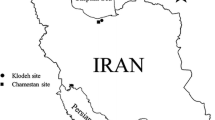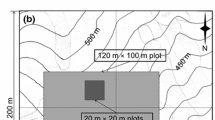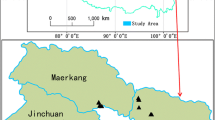Abstract
Decaying root systems of harvested trees can be a significant component of belowground carbon storage, especially in intensively managed forests where harvest occurs repeatedly in relatively short rotations. Based on destructive sampling of root systems of harvested loblolly pine trees, we estimated that root systems contained about 32% (17.2 Mg ha−1) at the time of harvest, and about 13% (6.1 Mg ha−1) of the soil organic carbon 10 years later. Based on the published roundwood output data, we estimated belowground biomass at the time of harvest for loblolly-shortleaf pine forests harvested between 1995 and 2005 in South Carolina. We then calculated C that remained in the decomposing root systems in 2005 using the decay function developed for loblolly pine. Our calculations indicate that the amount of C stored in decaying roots of loblolly-shortleaf pine forests harvested between 1995 and 2005 in South Carolina was 7.1 Tg. Using a simple extrapolation method, we estimated 331.8 Tg C stored in the decomposing roots due to timber harvest from 1995 to 2005 in the conterminous USA. To fully account for the C stored in the decomposing roots of the US forests, future studies need (1) to quantify decay rates of coarse roots for major tree species in different regions, and (2) to develop a methodology that can determine C stock in decomposing roots resulting from natural mortality.


Similar content being viewed by others
References
Adams, D.M., R.W. Haynes, and A.J. Daigneault. 2006. Estimated timber harvest by U.S. region and ownership, 1950–2002. USDA Forest Service, General Technical Report. PNW-GTR-659, 64 pp.
Baker, J.B., and O.G. Langdon. 1990. Pinus taeda L., loblolly pine. In Silvics of North America, vol. 1, conifers, ed. R.M. Burns and B.H. Honkala, 497–512. Agriculture Handbook 654. Washington, DC: USDA Forest Service.
Bentley, J.W., and R.A. Harper. 2006. Georgia harvest and utilization study, 2004. USDA Forest Service, RB-SRS-117, 25 pp.
Bentley, J.W., and T.G. Johnson. 2006. North Carolina harvest and utilization study, 2002. USDA Forest Service, RB-SRS-109, 23 pp.
Brown, J.K. 1974. Handbook for inventorying downed woody material. USDA Forest Service, General Technical Report, GTR-INT-16, 34 pp.
Cairns, M.A., S. Brown, E.H. Helmer, and G.A. Baumgardner. 1997. Root biomass allocation in the world’s upland forests. Oecologia 111: 1–11.
Ehman, J.L., H.P. Schmid, C.S.B. Grimmond, J.C. Randolph, P.J. Hanson, C.A. Wayson, and F.D. Cropley. 2002. An initial intercomparison of micrometeorological and ecological inventory estimates of carbon exchange in a mid-latitude deciduous forest. Global Change Biology 8: 575–589.
Fang, J.Y., G.G. Wang, G.H. Liu, and S.L. Xu. 1998. Forest biomass of China: An estimate based on the biomass–volume relationship. Ecological Applications 8: 1084–1091.
Hu, H.F., and G.G. Wang. 2008. Changes in forest biomass carbon storage in the South Carolina Piedmont between 1936 and 2005. Forest and Ecology Management 255: 1400–1408.
Jobbagy, E.G., and R.B. Jackson. 2000. The vertical distribution of soil organic carbon and its relation to climate and vegetation. Ecological Applications 10: 423–436.
Johnsen, K.H., J.D. Wear, R. Oren, R.O. Teskey, F. Sanchez, R. Will, J. Butnor, D. Markewitz, D. Richter, T. Rials, H.L. Allen, J. Seiler, D. Ellsworth, C. Maier, G. Katul, and P.M. Dougherty. 2001. Meeting global policy commitments: Carbon sequestration and southern pine forests. Journal of Forestry 99: 14–21.
Johnson, T.G., and P.S. Bischoff. 1999. South Carolina’s timber industry—an assessment of timber product output and use, 1997. USDA Forest Service, RB-SRS-46, 32 pp.
Johnson, T.G., R.A. Harper, and M.J. Bozzo. 2002. South Carolina’s timber industry—an assessment of timber product output and use, 1999. USDA Forest Service, RB-SRS-70, 42 pp.
Johnson, T.G., R.A. Harper, and M.J. Bozzo. 2004. South Carolina’s timber industry—an assessment of timber product output and use, 2001. USDA Forest Service, RB-SRS-89, 33 pp.
Johnson, T.G., A. Jenkins, D.P. Stratton, and P.S. Bischoff. 1997. South Carolina’s timber industry—an assessment of timber product output and use, 1995. USDA Forest Service, RB-SRS-16, 32 pp.
Johnson, T.G., and M. Knight. 2006. South Carolina’s timber industry—an assessment of timber product output and use, 2003. USDA Forest Service, RB-SRS-106, 47 pp.
Johnson, T.G., and N. Smith. 2007. South Carolina’s timber industry—an assessment of timber product output and use, 2005. USDA Forest Service, RB-SRS-121, 28 pp.
Jonsson, M., and D.A. Wardle. 2010. Structural equation modelling reveals plant-community drivers of carbon storage in boreal forest ecosystems. Biology Letters 6: 116–119.
Kapeluck, P.R., and D.H. Van Lear. 1995. A technique for estimating below-stump biomass of mature loblolly pine plantations. Canadian Journal of Forest Research 25: 361–365.
Laiho, R., and L. Finer. 1996. Changes in root biomass after water-level drawdown on pine mires in southern Finland. Scandinavian Journal of Forest Research 11: 251–260.
Ludovici, K.H., S.J. Zarnoch, and D.D. Richter. 2002. Modeling in situ pine root decomposition using data from a 60-year chronosequence. Canadian Journal of Forest Research 32: 1675–1684.
McCollum, M.M. 1992. Density and distribution of loblolly pine (Pinus taeda L.) roots along an environmental gradient. MS Thesis, Clemson University, Clemson, 62 pp.
Miller, A.T., H.L. Allen, and C.A. Maier. 2006. Quantifying the coarse-root biomass of intensively managed loblolly pine plantations. Canadian Journal of Forest Research 36: 12–22.
Petersson, H., and Y. Melin. 2010. Estimating the biomass and carbon pool of stump systems at a national scale. Forest Ecology and Management 260: 466–471.
Smith, J.E., and L.S. Heath. 2008. Carbon stocks and stock changes in U.S. forests. In U.S. Department of Agriculture. U.S. Agriculture and Forestry Greenhouse Gas Inventory: 1990–2005. Office of the Chief Economist. Technical Bulletin No. 1921, 65–80, C-1-C-7.
Ter-Mikaelian, M.T., and M.D. Korzukhin. 1997. Biomass equations for sixty-five North American tree species. Forest Ecology and Management 97: 1–24.
Trimble, S.W. 1974. Man-induced soil erosion on the Southern Piedmont, 1700–1970. Ankeny, IA: Soil Conservation Society of America, 80 pp.
Van Lear, D.H., P.R. Kapeluck, and M.M. Parker. 1995. Distribution of carbon in a Piedmont soil as affected by loblolly pine management. In Carbon forms and functions in forest soils, ed. W.W. McFee and J.M. Kelly, 489–502. Madison, WI: Soil Science Society of America.
Van Lear, D.H., P.R. Kapeluck, and W.D. Carroll. 2001. Productivity of loblolly pine as affected by decomposing root systems. In Forest soils and ecosystem sustainability, ed. J.R. Boyle and R.F. Powers, 435–444. New York, NY: Elsevier.
Wagner, R.G., and M.T. Ter-Mikaelian. 1999. Comparison of biomass component equations for four species of northern coniferous tree seedlings. Annals of Forest Science 56: 193–199.
Wear, D.N., and J.G. Greis. 2002. Southern forest resource assessment—summary report. USDA Forest Service, GTR-SRS-53, 103 pp.
Woodbury, P.B., J.E. Smith, and L.S. Heath. 2007. Carbon sequestration in U.S. forest sector from 1990 to 2010. Forest Ecology and Management 241: 14–27.
Acknowledgments
This paper is Technical Contribution No. 5928 of the Clemson University Experimental Station. We thank Ben Knapp for his editorial suggestions.
Author information
Authors and Affiliations
Corresponding author
Rights and permissions
About this article
Cite this article
Wang, G.G., Van Lear, D.H., Hu, H. et al. Accounting Carbon Storage in Decaying Root Systems of Harvested Forests. AMBIO 41, 284–291 (2012). https://doi.org/10.1007/s13280-011-0161-5
Received:
Revised:
Accepted:
Published:
Issue Date:
DOI: https://doi.org/10.1007/s13280-011-0161-5




